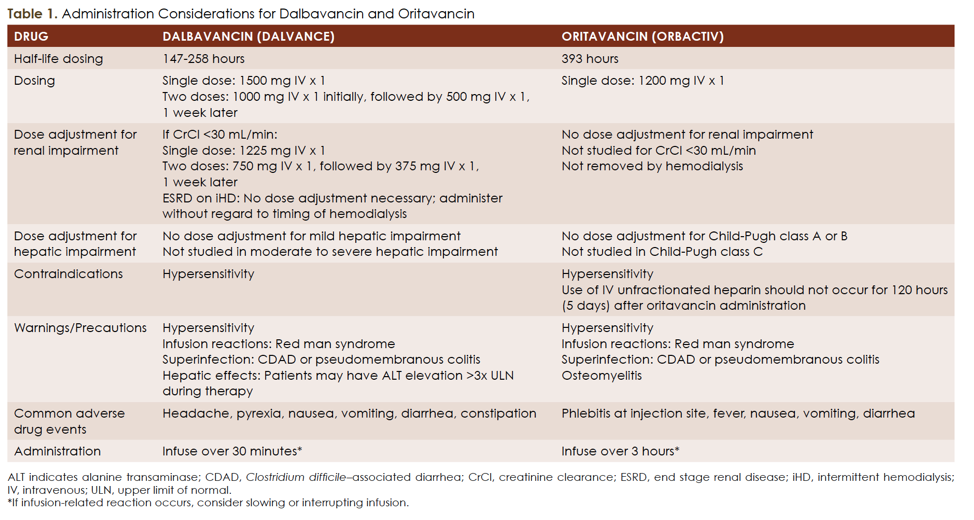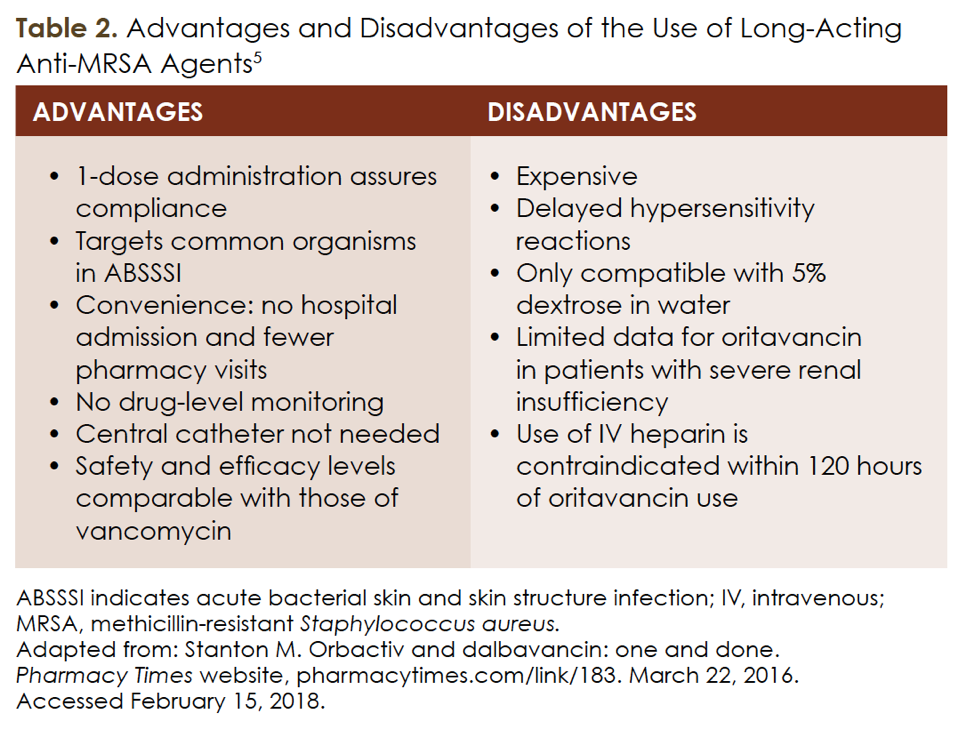Long-Acting Anti-MRSA Agents: One Dose to Cure?
A review of the current literature and future directions.
Methicillin-resistant Staphylococcus aureus (MRSA) is a significant cause of both health care—associated and community-associated infections.1 The most common types of infections caused by MRSA are skin and soft-tissue infections, bacteremia, infective endocarditis, pneumonia, and osteomyelitis.2 Per current guidelines, oral antimicrobials for the treatment of mild-to-moderate MRSA skin infections include trimethoprim/ sulfamethoxazole, clindamycin, doxycycline, minocycline, and linezolid.1 Alternatively, vancomycin tends to be the most common intravenous (IV) agent for empiric coverage of a potentially serious MRSA infection.1 Serious infections caused by MRSA have a high morbidity and mortality, with estimates for mortality as high as 30% to 37% with endocarditis.1 Treatment durations for MRSA infections can vary widely based on the site and source of infection.1 Because of growing resistance and the need for a single-dose treatment option to help patients avoid hospitalization, facilitate their earlier discharge, or eliminate their need for continued outpatient parenteral antimicrobial therapy (OPAT), long-acting anti-MRSA agents have been developed.
Dalbavancin (Dalvance) and oritavancin (Orbactiv) are semi-synthetic lipoglycopeptides with potent in vitro activity against multidrug-resistant gram-positive organisms, including MRSA.3 Both agents inhibit transglycosylation and transpeptidation, thus inhibiting cell-wall synthesis. Dalbavancin and oritavancin exhibit concentration-dependent, bactericidal activity. The presence of a lipophilic side chain in each molecule prolongs the half-life of the drug and permits 1-time dosing (see Table 1).2 Currently, dalbavancin and oritavancin are US Food and Drug Administration (FDA) approved for the treatment of acute bacterial skin and skin structure infections (ABSSIs).4,5 Advantages and disadvantages of using long-acting anti-MRSA agents are described in Table 2.6


The cited clinical scenarios of use for oritavancin and dalbavancin include patients seen in the emergency department (ED) who do not require hospital monitoring; completion of inpatient therapy to allow for earlier hospital discharge; patients in whom medical compliance would be an issue; and certain parenteral home-therapy cases.7 These potential therapeutic niches have been explored via cross-sectional studies and meta-analysis.
A recent systematic review, network meta-analysis, and cost analysis comparing the new lipoglycopeptides with standard care and with each other for the treatment of complicated skin and soft-tissue infections (cSSTIs) found that dalbavancin and oritavancin demonstrate efficacy and safety as compared with standard of care in randomized controlled trials (RCTs) (odds ratio [OR], 1.09; 95% CI, 0.90-1.33).8 Seven RCTs were included in the analysis. Moreover, no difference in clinical response between oritavancin and dalbavancin was seen (OR, 1.36; 95% CI, 0.85-1.18].8
Since the approval of these novel agents, hospital-based protocols have been initiated to evaluate their potential role in a clinical setting. Health care providers from many disciplines have been utilized to screen patients to the use of dalbavancin in the treatment of ABSSIs. At 1 site, patients were identified via an ED-initiated guideline for dalbavancin use. Of the 22 patients assessed for inclusion, 7 received dalbavancin. Patient follow-up was pursued and only 1 patient of the 7 required hospital readmission due to further complications. Such results demonstrate the potential for such a program and for the use of the agent with restricted guidelines.9
A similar study assessing the use of dalbavancin in EDs was completed via a retrospective cohort study describing the site’s experience with dalbavancin in the ED. All adult patients diagnosed with cellulitis and treated with dalbavancin over the span of 2 years had their medical records reviewed for patient characteristics, comorbidities, cellulitis severity classification, and length of stay. The average length of stay was 180 minutes for patients treated and discharged from the ED, and 1902 minutes for patients placed in observation. The researchers found that of the 23 patients included, 2 returned to the ED within 1 week for cellulitis-related complications. The use of this agent was not associated with frequent return to the ED or treatment failure.10
With regard to pharmacoeconomic outcomes, cost analyses demonstrated that, when compared with standard of care, dalbavancin and oritavancin were less costly in the scenarios evaluated.7 Per cSSTI, third-party payers saved between $1442 and $4830 and between $3571 and $6932 with the use of dalbavancin and oritavancin, respectively.8 Furthermore, with increasing pressure to reduce avoidable hospitalizations and the associated costs of inpatient care, these agents serve as an attractive treatment option.10
Regardless of the great potential these agents can provide, the ultimate future of oritavancin and dalbavancin is yet to be determined. Both the pharmacokinetics and the convenient 1-time dosing of these drugs make them alluring options for the treatment of gram-positive infections that otherwise require prolonged courses of antibiotics, such as osteomyelitis, endocarditis, and even bacteremia. However, recent literature searches mostly yield case reports of these drugs being used as alternative therapy for infections.
Intermittent dosing with oritavancin could potentially be a convenient addition for the treatment of osteomyelitis, but efficacy and safety data for this indication are lacking. Patients with osteomyelitis were excluded from the original phase 2 and phase 3 studies. One successful case study with the use of oritavancin was described in a patient with documented allergies to penicillin, cephalosporin, and erythromycin who developed a methicillin-sensitive Staphylococcus aureus (MSSA) right tibial infection. The patient received a preoperative dose of oritavancin 2 days prior to surgical debridement, then standard perioperative vancomycin during the surgery. After the surgery, the patient was treated with IV oritavancin 1200 mg per week for a total of 6 weeks. The patient was free of signs of infection on follow-up visits at 1, 4, 8, 12, 24, and 40 weeks after the end of therapy.11-13
The use of oritavancin was further tested in a case series of 10 patients in which the most common indication was MSSA bacteremia. Other indications included MRSA bursitis, group B Streptococcus bacteremia with native tricuspid valve endocarditis, coagulase-negative Staphylococcus bacteremia, MSSA deep-tissue infection, and enterococcal bacteremia. Oritavancin was well-tolerated and led to successful treatment of 70% of patients.14 Similarly, promising results were indicated by 1 case report with the use of dalbavancin in a patient with a history of recurrent MRSA bacteremia who had failed multiple courses of vancomycin and daptomycin. The patient was treated with dalbavancin 1000 mg IV weekly for 2 weeks followed by 500 mg IV weekly for 6 weeks. The original infection was shown to be cleared after therapy completion; however, the patient eventually developed MRSA bacteremia once more, showing that dalbavancin did not prevent recurrence.15
Dalbavancin has been compared with vancomycin in the setting of catheter-related bloodstream infections. A phase 2, open-label, randomized, controlled, multicenter study compared dalbavancin 1000 mg followed by 500 mg 1 week later with vancomycin administered twice daily for 14 days; the results indicated that the success rate of dalbavancin at 87% was significantly higher than that of vancomycin at 50%. Most frequently isolated bacteria were Staphylococcus spp., including coagulase-negative Staphylococcus and MRSA.16 Studies assessing dalbavancin’s role in osteomyelitis treatment are currently ongoing (NCT03426761; NCT02685033).
In addition to certain disease states, there are specific patient populations that may benefit from the reduced burden of administration of these longer-acting agents. Advances in the infrastructure for OPAT have been made, due to the increasing integration of home health care and infusion clinics. However, OPAT’s limitations still include cost, availability of services, the patient’s ability to be compliant with OPAT, and the potential need for in-dwelling catheters. Reported reasons for using long-acting MRSA agents over a more traditional OPAT regimen were history of IV drug use, patient refusal to participate in OPAT, patient desire to avoid OPAT, and history of noncompliance with OPAT.17
Another patient population in which long-acting anti-MRSA agents have been used are those who are attempting to transition to hospice care. One study outlined 3 case reports of oritavancin used in hospice care in which all 3 patients had advanced terminal cancer; had developed methicillin-resistant, gram-positive bacteremia (Streptococcus gallolyticus, Granulicatella adiacens, or MRSA); and were experiencing delay in hospice placement due to continued IV antibiotic therapy. Each patient received a single dose of oritavancin, then transitioned to hospice care. The patients died in hospice care between 2 and 5 weeks after administration of oritavancin.18
In conclusion, dalbavancin and oritavancin are promising novel agents for the treatment of gram-positive organisms. Although they are currently FDA approved only for the treatment of ABSSIs, they have potential use in the treatment of other infections, such as osteomyelitis and endocarditis. However, further studies, including randomized controlled trials, are still needed.
Dr. Monogue received a PharmD from the University of Texas at Austin College of Pharmacy, in Austin, Texas, and postgraduate training at Parkland Health and Hospital System (PGY-1) and the Center for Antiinfective Research and Development at Hartford Hospital (Infectious Diseases Fellowship). She is an active member of SIDP.
Drs. De Souza, Kent, and Mootz, are PGY-1 pharmacy practice residents at the University of Texas Southwestern Medical Center in Dallas, Texas, where Dr. Monogue is an infectious diseases and antimicrobial stewardship pharmacy specialist.
References:
- Liu C, Bayer A, Cosgrove SE, et al; Infectious Diseases Society of America. Clinical practice guidelines by the Infectious Diseases Society of America for the treatment of methicillin-resistant Staphylococcus aureus infections in adults and children [published correction appears in Clin Infect Dis. 2011;53(3):319]. Clin Infect Dis. 2011;52(3):e18-e55. doi: 10.1093/cid/ciq146.
- Tong SY, Davis JS, Eichenberger E, Holland TL, Fowler VG Jr. Staphylococcus aureus infections: epidemiology, pathophysiology, clinical manifestations, and management. Clin Microbiol Rev. 2015;28(3):603-661. doi: 10.1128/CMR.00134-14.
- Zhanel GG, Calic D, Schweizer F, et al. New lipoglycopeptides: a comparative review of dalbavancin, oritavancin and telavancin. Drugs. 2010;70(7):859-886. doi: 10.2165/11534440-000000000-00000.
- Dalvance [prescribing information]. Parsippany, NJ: Durata Therapeutic U.S. Limited; 2018.
- Orbactiv [prescribing information]. Parsippany, NJ: The Medicines Company; 2018.
- Stanton M. Orbactiv and dalbavancin: one and done. Pharmacy Times website. pharmacytimes.com/contributor/matthew-stanton-pharmd-bcps/2016/03/orbactiv-and-dalbavancin-one-and-done. Published March 22, 2016. Accessed February 15, 2018.
- Chen AY, Zervoc MJ, Vazquez JA. Dalbavancin: a novel antimicrobial. Int J Clin Pract. 2007;61(5):853-863.
- Agarwal R, Bartsch SM, Kelly BJ, et al. Newer glycopeptide antibiotics for treatment of complicated skin and soft tissue infections: systematic review, network meta-analysis and cost analysis [published online September 4, 2017]. Clin Microbiol Infect. doi: 10.1016/j.cmi.2017.08.028.
- Burgess DR, Baum RA, Bailey A, Myint T, Wallace KL. Impact of an antimicrobial stewardship and emergency department initiated dalbavancin guideline for patients with acute bacterial skin and soft tissue infections. Open Forum Infect Dis. 2017;4(Suppl 1):S267. doi: 10.1093/ofid/ofx163.589.
- Koziatek C, Mohan S, Caspers C, Swaminathan A, Swartz J. Experience with dalbavancin for cellulitis in the emergency department and emergency observation unit [published online November 17, 2017]. Am J Emerg Med. doi: 10.1016/j.ajem.2017.11.037.
- Corey GR, Kabler H, Mehra P, et al; SOLO I Investigators. Single-dose oritavancin in the treatment of acute bacterial skin infections. N Engl J Med. 2014;370(23):2180-2190. doi: 10.1056/NEJMoa1310422.
- Corey GR, Good S, Jiang H, et al; SOLO II Investigators. Single-dose oritavancin versus 7-10 days of vancomycin in the treatment of gram-positive acute bacterial skin and skin structure infections: the SOLO II noninferiority study. Clin Infect Dis. 2015;60(2):254-262. doi: 10.1093/cid/ciu778.
- Delaportas DJ, Estrada SJ, Darmelio M. Successful treatment of methicillin susceptible Staphylococcus aureus osteomyelitis with oritavancin. Pharmacotherapy. 2017;37(8):e90-e92. doi: 10.1002/phar.1957.
- Stewart CL, Turner MS, Frens JJ, Snider CB, Smith JR. Real-world experience with oritavancin therapy in invasive gram-positive infections. Infect Dis Ther. 2017;6(2):277-289. doi: 10.1007/s40121-017-0156-z.
- Almangour TA, Fletcher V, Alessa M, Alhifany AA, Tabb D. Multiple weekly dalbavancin dosing for the treatment of native vertebral osteomyelitis caused by methicillin-resistant Staphylococcus aureus: a case report. Am J Case Rep. 2017;18:1315-1319. doi: 10.12659/AJCR.905930.
- Raad I, Darouiche R, Vazquez J, et al. Efficacy and safety of weekly dalbavancin therapy for catheter-bloodstream infection caused by gram-positive pathogens. Clin Infect Dis. 2005;40(3):374-380.
- Lane S, Johnston K, Sulham KA, et al. Identification of patient characteristics influencing setting of care decisions for patients with acute bacterial skin and skin structure infections: results of a discrete choice experiment. Clin Ther. 2016;38(3):531-544; quiz 544.e1-e9. doi: 10.1016/j.clinthera.2016.01.007.
- Datta R, McManus D, Topal J, Juthani-Mehta M. Long-acting lipoglycopeptides for gram-positive bacteremia at the end of life to facilitate hospice care: a report of 3 cases. Open Forum Infect Dis. 2018;5(1):ofx277. doi: 10.1093/ofid/ofx277.

